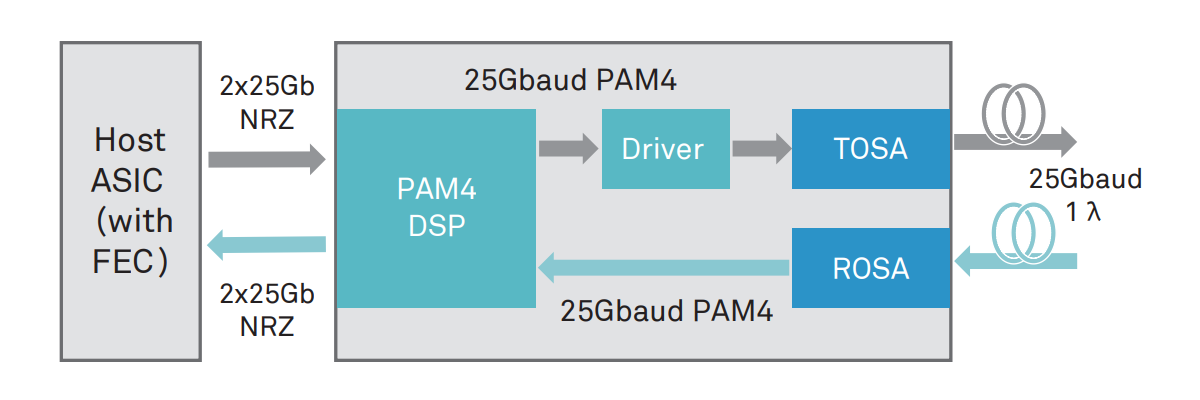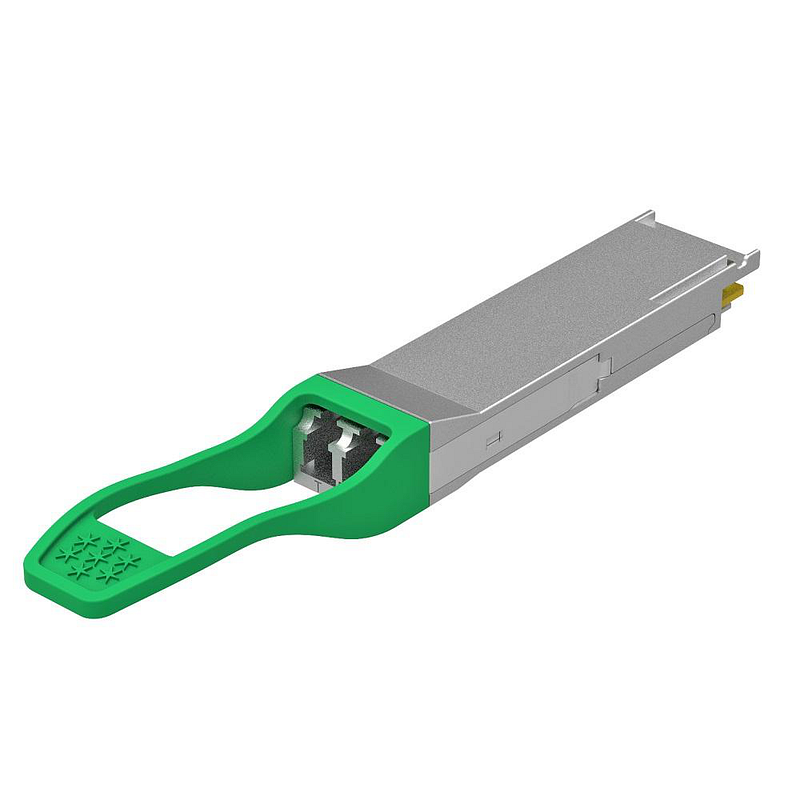January 28, 2019
With the PAM4 encoding technology, the amount of information transmitted on 50G PAM4-based optical transceivers within each sampling cycle doubles. A 25G optical component can be used to achieve a 50Gbps transmission rate, reducing the costs of optical transceivers.
50G PAM4 applies to multiple scenarios, such as single-lane 50GE PAM4 optical transceivers, 4-lane 200GE optical transceivers, and 8-lane 400GE optical transceivers.
Functions
This section introduces the functions of a single-lane 50GE PAM4 optical transceiver.

Working principle of a 50GE PAM4 optical transceiver
The working principle of a 50GE PAM4 optical transceiver is described as follows:
- In the transmit direction, the PAM4 encoding chip aggregates two 25Gbit/s NRZ signals into one 25GBaud PAM4 signal. The laser drive chip amplifies the PAM4 signal, and the 25Gbps laser converts the electrical signal into a 25GBaud(50Gbps) single-wavelength optical signal.
- In the receive direction, the detector converts the 25GBaud single-wavelength optical signal into an electric signal. The electric signal is shaped and amplified, and then output to the PAM4 decoding chip. The PAM4 decoding chip converts the signal into two 25Gbps NRZ signals.
The 50GE PAM4 optical transceiver uses the QSFP28 encapsulation mode, LC optical interfaces, and single-mode optical fibers. The transmission distance is 10km or 40km, and the maximum power consumption is 4.5W.
Specifications
The performance of transmitters and receivers on optical interfaces of 50GE PAM4 optical transceivers must comply with the IEEE 802.3bs and IEEE 802.3cd standards.
An optical transceiver provides N 25Gbps electrical interfaces. For a 50GE optical transceiver, the two electrical lanes transmit TX1/RX1 and TX2/RX2 signals specified in the SFF-8436_MSA standards. The performance of electrical interfaces must comply with the CEI-28G-VSR LAUI-2 standard.
The optical transceiver with a transmission rate of 50Gbps on a single wavelength supports 50GE, 200GE, and 400GE interfaces. The following table lists the parameters for the 50GE, 200GE, and 400GE technical solutions.

Technical Solutions
Optical Component and Drive Chip
50G PAM4 optical transceivers use mature 25Gbps optoelectronic chips to deliver cost-effective solutions. In 50GBASE-LR 10 km scenarios, uncooled Direct Modulated Laser (DML) Transmitter Optical Sub-Assemblies (TOSAs) with TO packaging are used. Such a solution features mature technologies, low costs, low power consumption, and easy mass production. The linear DML driver chip can convert input PAM4 voltage electric signals into current signals that can directly drive lasers. Such chips deliver a high bandwidth and output large drive current. Their maximum working rate can reach 28GBaud. At the receive end, Receiver Optical Sub-Assemblies (ROSAs) with TO packaging are used. 25Gbps pins and linear Trans-Impedance Amplifier (TIA) chips are integrated to the ROSAs.

Optical components in 50GBASE-LR scenarios
In 50GBASE-ER 40 km scenarios, 25Gbps Electro-absorption Modulated Laser (EML) TOSAs with BOX packaging are used. External cavity modulated Distribution Feed-Back (DFB) lasers, isolators, monitoring diodes, thermistors, and EML components are integrated to the TOSAs and driven by voltage signals. Such a solution features wide linear domains, high ER, high output optical power, and low TDECQ. Linear EML drive chips can amplify input PAM4 signals and output them to next EMLs. These chips provide a high bandwidth, a small jitter, an adjustable output gain, and a working rate up to 28GBaud. At the receive end, APD ROSAs with TO packaging are used. 25Gbps APDs and linear TIA chips are integrated into the ROSAs. Such ROSAs feature high sensitivity and apply to 40km long-distance transmission.

Optical components in 50GBASE-ER scenarios
PAM4 Chip
PAM4 codec chips perform conversion between NRZ signals and PAM4 signals inside transceivers. In the transmit direction, PAM4 chips shape, amplify, and convert two 25Gbps NRZ signals output by boards into one 25GBaud PAM4 signal. In the receive direction, PAM4 chips use the Analog to Digital Converter (ADC) and Digital Signal Processing (DSP) technology to decode the one 25GBaud signal to two 25Gbps NRZ signals.
Differences Between Solutions of NRZ and PAM4 Transceivers
The optical components and chips of PAM4 transceivers are very different from those of NRZ transceivers. The following table lists the differences between 50G QSFP28 LR and 25G SFP28 LR.

The main difference lies in laser drive chips, TIA chips, and data processing chips.
- Since PAM4 code has four types of level logic, the laser drive chips and TIA chips are capable of linear outputs. NRZ transceivers output signals in amplitude limiting mode.
- PAM4 transceivers use DSP to implement conversion between a 50G PAM4 signal and two 25Gbps NRZ signals. NRZ transceivers transmit data using Clock & Data Recovery (CDR) chips only.
Originally article: https://www.gigalight.com/show-1137.html
Posted by: datacenternews at
03:28 AM
| No Comments
| Add Comment
Post contains 743 words, total size 8 kb.
January 24, 2019
A significant portion of Data Center Interconnections (DCIs) and telecom router-to-router interconnections rely on simple ZR or 80km transceivers. The former is mostly based on 100Gbps per 100GHz ITU-T window C-band DWDM transceivers, while the latter is mostly 10G or 100G grey wavelength transceivers. In DWDM links, the laser wavelength is fixed to a specified grid, so that with DWDM Mux and Demux 80 or more wavelength channels can be transported through a single fiber. Grey wavelengths are not fixed to a grid and can be anywhere in the C-Band, limiting capacity to one channel per fiber. DCI links tend to use DWDM because they have to utilize the optical fiber bandwidth as much as possible due to the extremely high-volume traffic between data centers.
Another emerging 80km market is the Multi-System Operator (MSO) or the CATV optical access networks. This need emerges because MSOs are running out of their access optical fibers and they need a transmission technology which would allow them to grow to a very large capacity by using the remaining fibers. For this reason they need to use DWDM wavelengths to pack more channels in a single fiber.
The majority of the 10G transceivers on 80km links will be replaced by 100G or 400G transceivers in the coming years. For that to happen, there are two modulation techniques to enable 80km 100G transceivers.
- 50G PAM4 with two wavelengths in a 100G transceiver
- Coherent 100G dual-polarization Quadrature Phase Shifted Keying (DP-QPSK)
Generally speaking, PAM4 is a low-cost solution but require active optical dispersion compensation (which could be a big headache as well as extra expense to data center operators) and extra optical amplification to compensate for the dispersion compensators. By contrast, Coherent approaches do not need any dispersion compensation and the price is coming down rapidly, especially when the same hardware can be configured to upgrade the transmission data rate per wavelength from 100G to 200G (by using DP-16QAM modulation).
When 400G per wavelength is needed in a DCI network within a 100GHz ITU-T window, coherent technology is the only cost-effective solution, because it will not be feasible for PAM4 to achieve the same high spectral efficiency of 4 bit/sec/Hz.
On the standards front, many standards organizations are adopting coherent technology for 80km transmission. The Optical Inter-networking Forum (OIF) will adopt coherent DP-16QAM modulation at up to 60Gbaud (400G per wavelength) in an implementation agreement on 400G ZR. This is initially for DCI applications with a transmission distance of more than 80km, and vendors may come up with various derivatives for longer transmission distances. Separately, CableLabs has published a specification document for 100G DP-QPSK coherent transmission over a distance of 80km aimed at MSO applications. In addition, IEEE802.3ct is in the process of adopting coherent technologies for 100G and 400G per wavelength transmissions over 80km.
As data rates increase from 100G to 400G and capacity requirements per fiber are driven by DCI needs, and assisted by volume driven cost reductions in coherent optics and in coherent DSPs, we expect coherent transmission to be the technology of choice for 80km links.
Posted by: datacenternews at
07:54 AM
| No Comments
| Add Comment
Post contains 523 words, total size 4 kb.
January 22, 2019
Since 2018, 100G high-speed optical transceivers have been deployed in large-scale data centers. The 100G QSFP28 series products are favored in large data center network architectures such as Microsoft, Google, and Facebook.
The 100G QSFP28 PSM4, 100G QSFP28 CWDM4, 100G QSFP28 LR4 optical transceiver is widely used in the construction of data center networks. It has won a large market share compared to other 100G optical transceivers. It can be said that it is a popular product in 100G high-speed optical transceivers. In general, if a product can be recognized by the market and widely used, the technical advantage must be the important reason.
Gigalight 100G PSM4, 100G CWDM4, 100G LR4 are using for data center. These products use technologies such as COB, WDM, mini TO and so on, which greatly reduced the cost, can save money for high-volume optical transceivers in the data center.
 100G PSM4
100G PSM4 100G CWDM4
100G CWDM4 100G LR4
100G LR4
Automated Production and Chip-On-Board(COB) Packaging Technology
The chip-on-board package technology is an illuminant in which multiple of LED chips are integrally packaged on the same substrate.
Gigalight 100G QSFP28 PSM4, 100G QSFP28 CWDM4, 100G QSFP28 LR4 optical transceivers use automated production line and COB technology, greatly reducing cost and product power consumption.
WDM technology
In addition to COB technology, Gigalight 100G QSFP28 CWDM4 and 100G QSFP28 LR4 optical transceivers all introduce WDM technology. In optical transmission networks, WDM technology is considered to be an effective means to expand the transmission capacity of existing optical networks. It can increase the optical signal transmission capacity of existing optical fibers in the most cost-effective way, thus quickly meeting the increasing high bandwidth requirements of people. The most direct impact on life is that we go online, watch TV, make calls faster and more smoothly.
Wavelength Division Multiplexing (WDM) is a Multiplexer (Mux) that multiplexes optical carrier signals of different WDM wavelengths onto a single fiber for transmission at the transmitting end, and then uses a Demultiplexer(Demux) at the receiving end to transmit each the WDM wavelength separation technology, each WDM wavelength signal is independent of each other and is not affected by any transmission protocol and rate.
In addition, WDM technology enables bidirectional transmission of optical signals over a single fiber. This technology virtualizes one fiber into multiple fibers, which not only simplifies the structure of the optical transmission network, but also greatly saves fiber resources, thereby reducing the deployment cost of the optical network.

Using Mini TO Technology
Gigalight uses homemade Mini TO to effectively reduce costs and improve product reliability.
Conclusion
Through long-term technical accumulation, Gigalight self-developing optical devices, homemade TOSA/ROSA, gradually formed its own transmitting and receiving device packaging technology platform. The transmitter adopts the self-made mini TO plus AWG chip, and the receiving end adopts the COB packaging process, which greatly optimizes the product cost. In 2019, 100G optical transceivers will still occupy a mainstream position in data center deployment. In the new year, Gigalight will continue to optimize its production technology and will provide more high-quality 100G high-speed optical interconnect products for data centers.
Posted by: datacenternews at
07:49 AM
| No Comments
| Add Comment
Post contains 518 words, total size 5 kb.
32 queries taking 0.0323 seconds, 48 records returned.
Powered by Minx 1.1.6c-pink.









